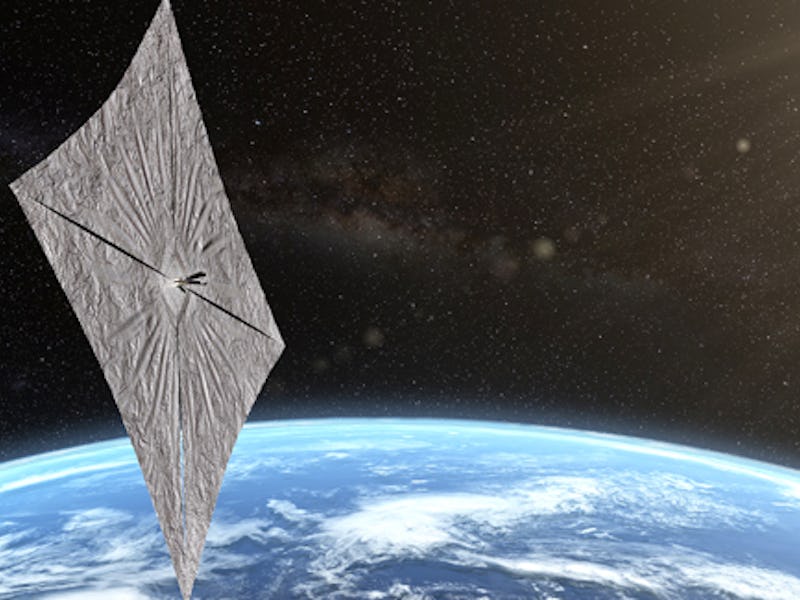LightSail 2 Successfully Soars Through Space, Propelled Only by Sunlight
"We could ferry cargo to Mars and look for signs of life, and change the course of human history."

LightSail 2, the latest experiment to explore the concept of “solar sailing” — space travel propelled by particles of quantum light that radiate from our sun — was a resounding success, proving that the technology could one day be used to propel cargo to Mars and visit new star systems.
An announcement Wednesday revealed that the satellite has successfully raised its orbit around Earth as a result of sunlight pushing on the vehicle’s large, reflective solar sail. This marks the first time a spacecraft in Earth’s orbit has used the momentum of photons to change its direction around our planet.
"It’s very romantic that you’ll be sailing on sunbeams."
“LightSail 2 will fly for another almost a year. And we are going to learn a lot about controlling the spacecraft and the performance of the sails in the coming months,” Bill Nye, CEO of the Planetary Society, the non-profit organization behind the mission, tells Inverse.
“We could ferry cargo to Mars and look for signs of life, and change the course of human history,” he noted in a press conference. “How about that?”
A concept animation showing how the sails unfolded, albeit much slower, while the Cubesat was in orbit
The experimental Cubesat was tucked inside Prox-1, a suitcase-sized carrier spacecraft, and launched into orbit on a SpaceX Falcon Heavy rocket from Kennedy Space Center on June 25th.
"The key for solar sailing is that the source is always there” — Dr. Bruce Betts
“This technology enables us to take things to extraordinary destinations from the solar system and maybe even beyond in a way that’s never possible before, because you don’t need fuel, and you don’t need all those systems to control fuel, and manage fuel, and handle fuel, and buy fuel. You don’t need all that,” Nye said.
All hands, make sail!
Following a series of systems checks, the spacecraft successfully deployed its sail — a thin, square piece of mylar, roughly the same size as a boxing ring — on July 23. Since then, its orbit has been carefully adjusted to maximize the sail’s efficiency and catch as much of the sun’s power as possible. According to the Planetary Society, LightSail 2 has raised part of its orbit about 1.7 kilometers, a change that “can only be attributed to solar sailing.”
“That the total force on the sail is approximately equal to the weight of a house fly on your hand on Earth gives you an idea of how small it is. But again, the key is that it’s constant. It’s always there,” says Dr. Bruce Betts, the Planetary Society’s chief scientist and program manager for LightSail 2.
View of the actual deployment of half of LightSail 2's square sail from camera one (at about 100 times real speed)
“In terms of the amount of force that solar pressure is going to exert on us, it’s in the micronewton level. It’s very tiny compared to chemical propulsion, or very small even compared to a electric propulsion — but the key for solar sailing is that the source is always there. So even though you were at the micronewton level of force, that level of force is always there, and you’re able to use it to accelerate the spacecraft and go where you want to,” says David Spencer, project manager for LightSail 2.
"The total force on the sail is approximately equal to the weight of a house fly on your hand.” — Dr. Bruce Betts
In order to reach stars or even other planets, a solar-sailing spacecraft could be given “a push” in order to build up greater velocity.
A concept of a solar-sailing starship capable of travelling interstellar distances to other stars
“You would hit it with lasers, based on the Earth, or perhaps on the far side of the moon, and give this spacecraft a push to nearby solar systems, in times that would be imaginable in a human lifetime, a few decades rather than a few tens of thousands of years,” says Nye.
Come up the larboard topsail sheets!
“NASA’s Near-Earth Asteroid mission, or NEA scout is scheduled to launch on the first launch of the Space Launch System, the large launch vehicle, the NASA is developing. Sometime in mid-2020 is the current plan…and we’ve got a NASA Space Act Agreement to share the technologies and findings from this mission,” Spencer tells Inverse.
This animation shows how LightSail 2 raises its orbit by making two 90-degree turns each orbit. As the spacecraft approaches the Sun, it turns the sail edge-on to avoid getting pushed by solar photons. As it moves away from the Sun, it turns perpendicular to incoming sunlight, giving it a push that gradually raises its orbit.
“So the NEA Scout engineers have been working with us and attending our reviews, and we’ve even had them on some of our telecons recently discussing the technical aspects of the mission. So we’re feeding forward findings from this mission. We hope that that’s beneficial to them, and we really look forward to them carrying solar sailing technology to the next level for science objectives,” Spencer says.
“We have no plans to do a third LightSail right now. But we do plan to have, or we are involved in, having an international competition for formal proposals for what would be next for the Planetary Society. If a solar sail formal proposal emerges that is reasonable and worthy, then we would pursue that,” says Nye.